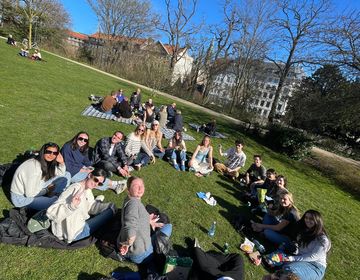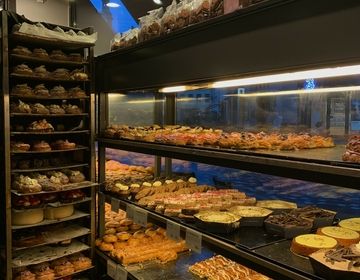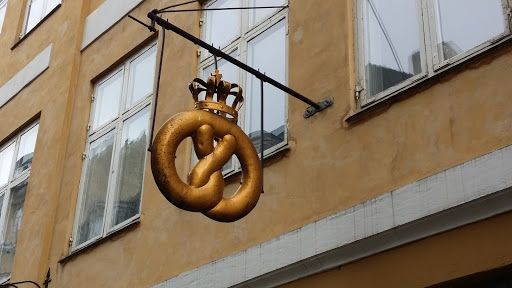What Your Favorite Danish Pastry Says About You
When most people in the States say “Danish”, they usually mean the pastry and not the language native to the author of The Little Mermaid – and with good reason. Danishes are absolutely delicious, and DANISH Danishes... well, let’s just say that they have earned that name.
However, before we even begin with the article, we have a small confession to make – Danishes aren’t actually Danish. In fact, in Denmark we call them wienerbrød or Viennese bread named after the capital of Austria which is where we got the idea for the delicious layered pastries after a worker’s strike amongst Danish bakers in 1850 forced bakeries to hire foreign workers from particularly Vienna (or Wien) in Austria, who then brought their own pastries and baking techniques to the country. Especially their Plundergebäck grew popular amongst the Danes, who then altered the recipe by adding a little more egg and butter. We then exported them further out into the world, where they earned their new English name – the Danish.
But even though Danishes aren’t technically Danish, we have made an art of them here in Copenhagen over the past 170 years and there are a wealth of them to choose from in bakeries big and small all over the city. But where to even start? If you are in need of a masterclass in the most popular pastries and where you can get them in Copenhagen, look no further, this article is for you. Or if you already have a favorite and would like to know what that says about you, well, we’ve got you covered there too. Alright, let’s begin.
Kanelsnegl: Cozy and Classic
Get it at: Bagerdygtigt, Valby Langgade 185, 2500 Valby, Istedgade 120, 1650 København V, Amagerbrogade 72, 2300 København S, Borgbjergsvej 39, 2450 København SV og Enghavevej 71, 1674 København V
Kanelsnegle, or directly translated “cinnamon snails” are a staple of Danish bakeries, a type of pastry that you will be sure to find wherever you go in Copenhagen or across Denmark. Composed of pastry dough folded into the shape of a snail shell and peppered with cinnamon (thereof the name) you can usually find it wherever there are Danes – children's birthday parties, Circle K’s on the highways, bake sales, you name it. Simply put, kanelsnegle are Danish hygge (link to our blog post on that here) encapsulated in a pastry. Kanelsnegle are also the basis of the classic “onsdagssnegl” or Wednesday snail, a larger kanelsnegl that you usually can get for a pretty decent price every Wednesday.
If your favorite Danish pastry is the “kanelsnegl”, you’re not one to be fooled by false pretension or shiny facades – you know true worth when you see it (or, well, taste it). You’re down to earth and a good friend who’s great at making everyone around you feel at ease in your presense. You often settle for comfort more than adventure, but that doesn’t take away from the fact that you’re a very popular person to be around.
Kardemommesnurre: Aesthetic and Aspirational
Get it at: Juno the Bakery, Århusgade 48, 2100 København
Kardemommesnurrer are a piece of intricately swirled bread topped with cardamom hailing from Sweden. Juno the Bakery in Østerbro is famous around the world for their exceptionally fine kardemommesnurrer, otherwise if you’re feeling up for a little adventure over the Øresund bridge you can take the train to Malmö in the homeland of the snurrer and get them for “fika” (a special Swedish word for a coffee or cake break spent in the good company of others, something just as integral to Swedish culture as hygge is to Danish).
If kardemommesnurrer are your exact thing, you’re someone who has an eye for aesthetics, who knows how to curate the perfectly mouth-watering Instagram-coffeeshop-study-session photo with this beautiful little creation in the very forefront. You have vivid and colorful dreams that involve traveling the world with your camera and journal and documenting everything you see along the way. You have a big heart with imagination to spare, and this is a something that you enjoy sharing with others.
Spandauer: Rebellious and Reveling
Get it at: BUKA, Store Kongensgade 18, 1264 København
A spandauer, also known in Denmark as “bageren’s dårlige øje” or the baker’s bad eye, is probably the pastry that comes to the mind of most people when they hear the word Danish. It is an almost bowl-shaped pastry with a sugary mass in the middle, topped with hazelnuts, jam and glaze. The name “spandauer” refers to a neighborhood in the German capital of Berlin where an infamous prison was situated – the spandauer being built almost like such a prison, with four “towers” keeping the sugary cream locked inside the walls of the pastry. Despite the quite unappealing origin story of this baked good, it has definitely stood the test of time and remains a classic at any Danish baker’s.
If the spandauer is your preferred option at a bakery, you are a person with something on your heart, as we also say in Denmark. You like to speak up and make your thoughts and opinions known, even though it might get you into trouble sometimes. You are more ballsy than ballet (clumsy 80’s band reference intended), and will kick down any door that stands between you and your goals.
Tebirkes/Frøsnapper: Funky and Flexible
Get it at: Andersen Bakery, Thorshavnsgade 26, 2300 København S
A dual pastry in two different forms (“dobbeltkonfekt”, as we Danes say), tebirkes (“tea poppy seeds”) and frøsnappere (“frog snappers”, and yes we know that that is a strange name) are essentially the same pastry, the only marked difference being that frøsnappere are shaped into a sort of twist that kind of resembles an breadstick, whilst tebirkes are folded onto themselves into a roll. Frøsnappere are also named after a beloved children’s book character, Orla Frøsnapper from Ole Lund Kirkegaard’s novel of the same name from 1969, an infamous bully known for, well, having once snapped up a frog and eaten it, supposedly.
If the frog snapper is your fave, you are someone who likes to go with the flow and not particularly commit to any sort of aesthetic and lifestyle, instead preferring to embrace whatever feeling or flight of fancy that comes to you that day. You don’t like to restrict or inhibit yourself, and you always seem to find the adventure and the magic in everything that you do.
Kringle: Laudable and Loyal
Get it at: Sankt Peders Bageri, Sankt Peders Stræde 29, 1453 København
Kringler are the classic Danish twisted pretzel, although unlike their German cousin the Brezel and their American counterpart, the kringle is sweet instead of salty and filled with remonce (creamed butter and sugar). Like the romkugle, the kringle is also a pastry with great significance to Danish baker culture, although its significance lies more in its history and symbolism than its economic and ecological benefits. Outside many Copenhagen bakers, and especially ones like Sankt Peders Bageri near the Church of Our Lady (the oldest bakery in Copenhagen, and also very known for their “onsdagssnegle”) you will find a logo of a kringle topped with a crown. This stems again from Vienna, where the Austrian bakers were rewarded with being allowed to display a crown in their logo after they helped fend off the Ottoman (Turkish) invasion of the city in 1529.
If you are crazy for kringler, you are a fierce friend willing to do whatever it takes in service of a loved one. You are a born winner with fire in your veins, and you don’t back down easily from a challenge. You prize yourself on being able to distinguish right from wrong and to make the correct choices, not for praise but for your own integrity.
Romkugle: Eco-Conscious and Earnest
Get it at: H.U.G. Bageri (gluten free and vegan bakery) Øster Farimagsgade 20, 2100 København
While its name literally translates to something as appetite-decreasing as “rum ball”, one must not be fooled by the humble nature of the romkugle – it is actually the bread and butter of the Danish baker, so to speak. Not technically “wienerbrød”, romkugler are typically made with whatever leftover cakes and pastries a baker has after a long day in the shop. Due to the fact that a baker can’t sell cakes from the day before, they would otherwise have to have thrown them completely out, which is a massive pity, especially considering how food waste is one of the greatest problems of our time. Luckily, if you just add a little rum essence (not to worry, it’s not the kind of rum that pirates drink) and cocoa and roll the entire concoction in coconut, the result will taste good as new – or maybe even better.
If romkugler are your go-to baked good when you’re picking your pastry of the day, you’re a person who knows the importance of taking care of our planet and takes pride in doing what you can to minimize your own waste, but you’re not preachy or high-and-mighty about it. You bike everywhere you go in the city, so gorging on your favorite Danish delicacy every once in a while is completely allowed, especially since you’re kind of saving the world while you do it. Go you!
That concludes our post on what your favorite Danish pastry says about you. I hope you’ve enjoyed this listopic and history lesson, and hopefully learned something about both perhaps yourself but also the pride we take in our baked goods here in Denmark.
Now then, all this pastry-prattle has made me hungry. I think I’ll go down and get a Danish of my own. Only, what should I get... Perhaps I’ll let the baker choose for me and see what happens :)
Related Posts

The Bike Trip That Didn't Happen (Yet)
Written by Catherine Ripsteen student from Open Campus Spring Block 3 2025: The Bike Trip That Didn't Happen Date: 4/02/25 Copenhagen is consistently ranked as one of the world’s most... keep reading
Horseback Riding in Madrid
By: Shafa Abbas Madrid offers an abundance of amazing experiences—iconic activities like visiting the Museo del Prado or strolling through El Retiro Park. But for me, the most unforgettable thing... keep reading

Hygge: One of the best parts of Danish culture
Written by: Grace Beaster a student from: Open Campus Sring Block 1 2025 One of the best parts of Danish culture that I’ve discovered while here is a concept called... keep reading

